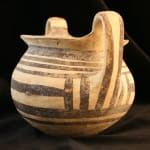Daunian Bichrome Terracotta Bowl with Two Handles, 500 BCE - 300 BCE
Terracotta
12.7 x 15.9 cm
5 x 6 1/4 in
5 x 6 1/4 in
CK.0008
Further images
In the eighth century B.C., Greek settlers left their homeland behind and established a string of colonies along the Adriatic coast of Southern Italy. After the rise of Rome centuries...
In the eighth century B.C., Greek settlers left their homeland behind and established a string of colonies along the Adriatic coast of Southern Italy. After the rise of Rome centuries later, this region would become known by the Latin term Magna Graecia, literally “Greater Greece,” due to the dense concentration of Greek settlements. The Greeks flourished here alongside the native populations, amassing great wealth through trade and importing their Hellenic culture throughout the area. They in turn were influenced by their neighbors, so that Magna Graecian pottery developed into a unique style that reflected both Greek and native Italian traditions. The Daunians were one such native culture that lived alongside the Greek colonies. Daunian pottery can be characterized by its rounded forms, geometric, linear designs, and eathern tones. The Greeks adopted some of the Daunian forms for themselves, revealing the cultural interplay that so distinguishes the art of Magna Graecia, both in respects to the Greeks as well as the native peoples such as the Daunians.
Of a spherical body with flaring mouth and two handles that emerge from the rim and connect to the middle of the body, this vessel is decorated in painted lines characteristic of the Daunian style. The sides of the handles are enhanced by two thick black lines, while a series of horizontal lines of varying thickness adorn the body. Similar in form to an amphora or pelike, we can extrapolate that this vessel would have served a similar function as storage for grain, wine, or other perishable comestibles.
Of a spherical body with flaring mouth and two handles that emerge from the rim and connect to the middle of the body, this vessel is decorated in painted lines characteristic of the Daunian style. The sides of the handles are enhanced by two thick black lines, while a series of horizontal lines of varying thickness adorn the body. Similar in form to an amphora or pelike, we can extrapolate that this vessel would have served a similar function as storage for grain, wine, or other perishable comestibles.









